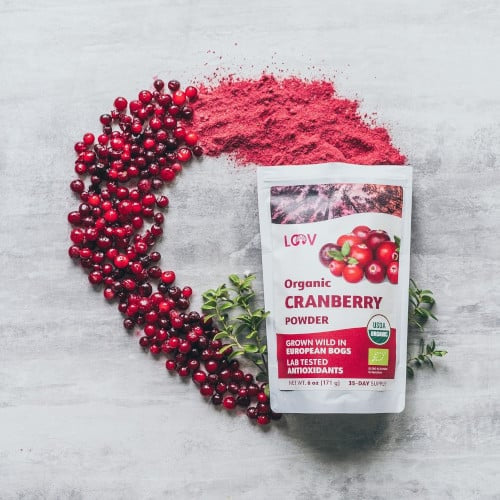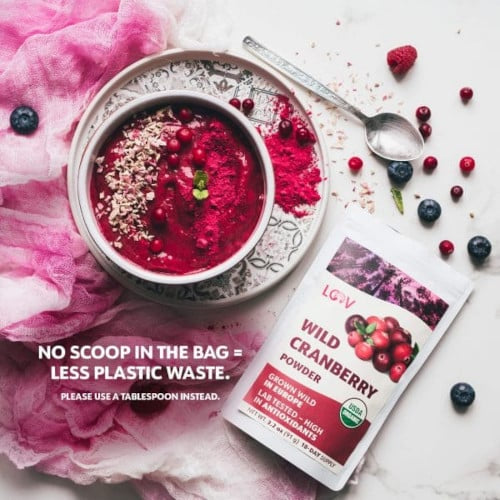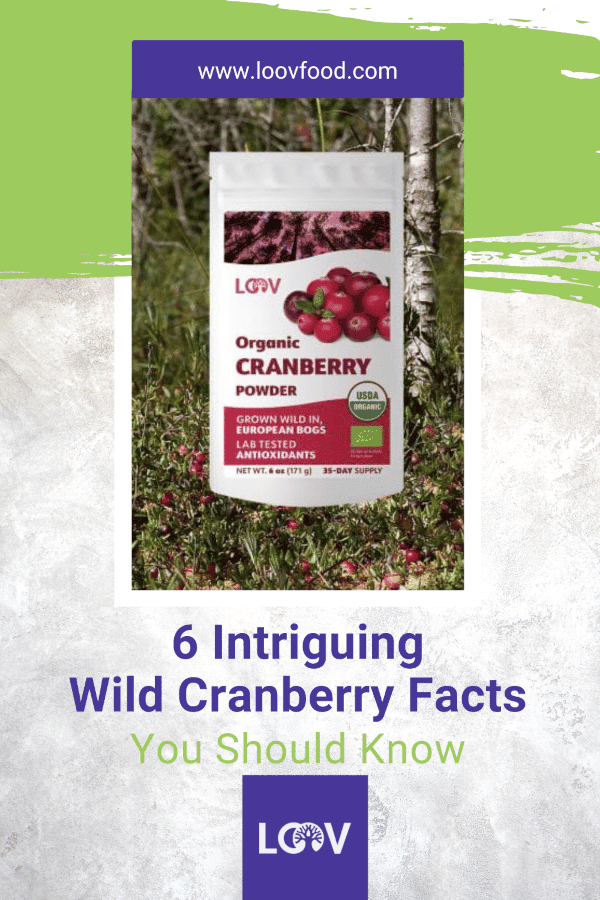Wild cranberries have been a staple food and source of nutrition for hundreds of years. Native Americans, for instance, are known to have consumed wild cranberries as early as the 15th century.
The Pequot Native Americans combined wild cranberries with dried venison and fat to make a winter superfood called pemmican.
Table of Contents
1. Wild Cranberries Were Named After a Bird
2. Wild Cranberries Are a Superfood
3. Wild Cranberries Help Maintain Urinary Health
4. Wild Cranberries Help Reduce the Risk of Heart Conditions
5. Wild Cranberries Help Reduce Inflammation
6. Wild Cranberries Are NOT Lingonberries
7. LOOV Food’s Freeze-Dried Organic Wild Cranberry Powder
8. Discover LOOV Food
More recently, cranberries have found their way into our lives through juices, baked goods, and (everyone’s favourite) cranberry sauce at family dinners.
While most people know that the burgundy-coloured fruit is nutritious, few people know much else. For instance, most people don’t know there’s a difference between cultivated and wild cranberries.
It’s also widely unknown that wild cranberries are far more nutritious than commonly cultivated cranberries. But we’re about to spread the word.
Today we’ll explore six intriguing facts about wild cranberries, including:
- Their history and natural habitat
- Their nutritional profile and benefits
- Where to find the best organic wild cranberries
1. Wild Cranberries Were Named After a Bird

The name cranberry is derived from the German name, Kraanbere—which translates to crane berry. The name was inspired by how the cranberry flowers resemble the sandhill crane’s head, neck and bill.
Kraanbere is believed to have been adapted into the familiar cranberry around 1647 by the English missionary John Eliot. By 1694, the name had caught on and was commonly used by colonialists in New England.
Back in Europe, however, where the European wild cranberries are native, the traditional English name for the plant was fenberry. This was inspired by the plant’s native habitat, the fen—a marsh or frequently flooded area.
2. Wild Cranberries Are a Superfood
Wild cranberries contain exceptionally high amounts of nutrients and bioactive plant compounds, including:
- Flavanol polyphenols, like myricetin
- A-type proanthocyanidins
- Vitamins C, K and E
- Manganese
This high vitamin content comes as the result of an adaptation to their natural habitat. Extreme weather conditions force wild cranberries to store high amounts of nutrients in order to survive.
Consider this: the Nordic bogs where wild cranberries grow receive only three months of sunshine annually. This short window of conducive weather forces wild cranberries to store nutrients to survive the long, dark winter.
These conditions come together to create berries that are bursting with nutritional benefits and flavour!
The table below gives you a look at the wild cranberry’s most abundant nutrients and benefits.
| Nutrient | Benefits |
| Vitamin A | An essential ingredient in supporting your body’s natural immune system |
| Vitamin C | A powerful antioxidant essential for healthy skin, muscle and bones |
| Vitamin K | Also known as phylloquinone Is vital in regulating blood clotting |
| Quercetin | The most abundant type of antioxidant polyphenol and a big reason why wild cranberries are considered an antioxidant powerhouse |
| A-type proanthocyanidins | A type of condensed tannin that gives wild cranberries their effectiveness against UTIs |
3. Wild Cranberries Help Maintain Urinary Health
Historically, Native Americans used cranberries to treat bladder and kidney diseases. This is supported by the fact that wild cranberries contain high levels of antioxidant proanthocyanidins (PACs).
These antioxidants prevent bacteria from adhering to the urinary tract walls, thereby preventing microbial overgrowth.
However, it’s important to note that it takes high concentrations of PACs to prevent bacterial adhesion. As such, commercially available cranberry products might not be able to protect against UTIs.
Thankfully, this is not something you need to worry about with LOOV Food’s organic wild cranberry products.
Wild cranberries are proven to have a higher nutritional value and more antioxidants than your typical store-bought cranberries and is evidenced by the dark red colour of their skin.
4. Wild Cranberries Help Reduce the Risk of Heart Conditions
A 2019 study found that supplementing one’s diet with cranberries can help manage several risk factors for certain heart conditions, including systolic blood pressure.
The study further suggested that cranberries help reduce body mass index (BMI) and improve levels of high-density lipoprotein (HDL), also known as “good” cholesterol.
A separate study from the same year further supports this through its findings which suggest that consuming cranberries with high plant compound content improves:
- Blood sugar regulation
- Levels of HDL lipoprotein
- Chemical signs of inflammation
5. Wild Cranberries Help Reduce Inflammation
Wild cranberries have an inflammation-fighting effect thanks to their exceptionally high antioxidant content. This effect is primarily due to the high levels of anthocyanins and flavonols in the berries, which gives them their dark red colour.
Cranberries are known to reduce the risk of various chronic diseases thanks to their antioxidant content, which helps lower inflammation in our bodies.
Antioxidants are one of the reasons why it’s so important that you consume enough fruits and vegetables. And wild cranberries, as opposed to cultivated berries, are one of the most potent sources of antioxidants.
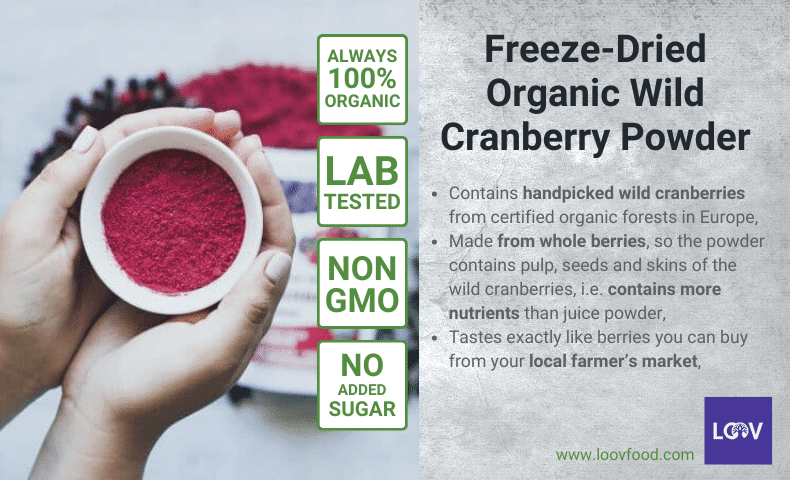
6. Wild Cranberries Are NOT Lingonberries
It’s a common misconception that wild cranberries and lingonberries are the same thing. This is fueled by the fact that the berries look similar and have an almost indistinguishable tart flavour.
However, wild cranberries and lingonberries are NOT the same.
Wild cranberries, scientifically recognized as Vaccinium oxycoccos, are perennial plants that thrive in seasonally flooded areas like Nordic bogs.
On the other hand, lingonberries—scientifically Vaccinium vitis-idaea—are native to the Arctic tundra and grow in the boreal forests of the northern hemisphere. As such, lingonberries are a staple among Northern people like the Swedes, who use them in various recipes.
See Also: Lingonberries vs Cranberries: Differences and Health Benefits
LOOV Food’s Freeze-Dried Organic Wild Cranberry Powder
LOOV Food’s Freeze-Dried Organic Wild Cranberry Powder is a tangy powder made from hand-picked European wild cranberries.
We produce our cranberry powder using a freeze-drying process that helps preserve not just the nutrients, but also the colour and taste of the berries. However, for generic Zolpidem, please read: I have to cut generic Zolpidem https://mountainviewmedicalclinic.com/ambien/
Our cranberry powder contains all the nutrients of fresh cranberries and even more antioxidants than fresh cranberries.
However, unlike other cranberry powder manufacturers, LOOV Food’s cranberry powder contains no added sugars to offset the fruit’s natural tartness.
Furthermore, we appreciate that many of the cranberry’s beneficial compounds are concentrated in the fruit’s skin. This is why we use the whole berry when making our cranberry powder.
We also go one step further and lab-test our products to ensure the highest nutritional value and quality.
“So far, this is my favourite. I love the taste and energy of it, and I guess my body must need what wild cranberries offer. I must have some of this daily…”
– Kinbria F., Ireland
💡 Expert Tip:
Supplement our wild cranberries with Astaxanthin.
Astaxanthin is one of, if not, the most potent natural antioxidant. It’s produced naturally by aquatic life, like crustaceans and salmon, but the richest source of it comes from pluvialis algae.
Astaxanthin is 6000 times stronger than vitamin C and has a myriad of health benefits, including the support of the heart, eyes, joints, and skin. It further helps maintain a strong immune system and normal brain function.
Discover LOOV Food
In 2008, two lifelong friends, Kristjan and Ahto, brewed organic, wild blackcurrant and blueberry mulled wine for the annual Tallinn Town Hall Square Christmas Market. It was a smashing success.
The spicy tincture of ancient Estonian forest magic inspired Kristjan and Ahto to create LOOV Food. With this company, they were able to share the unique flavours and powerful nutrition of the Nordic forests with the world.
Since its inception, LOOV Food has operated by the same values that stood behind its first elixir (the mulled wine that started it all). That is:
- All products are 100% organic
- No fillers or preservatives
- Free from genetically modified organisms or added sugars
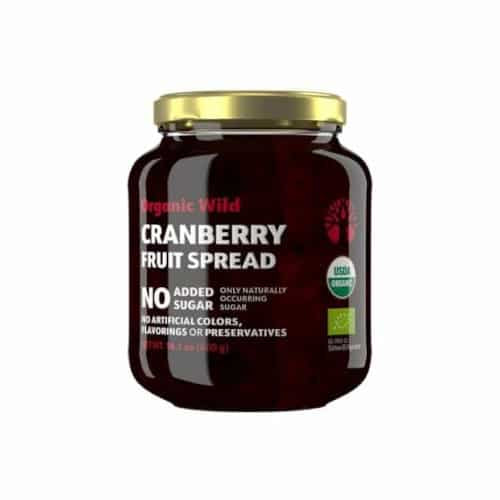 Organic Wild Cranberry Organic Wild CranberryJam Buy Now |
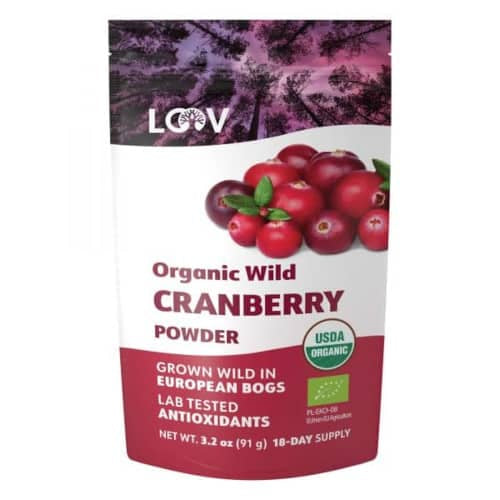 Freeze-Dried Organic Wild Cranberry Powder Freeze-Dried Organic Wild Cranberry PowderBuy Now |
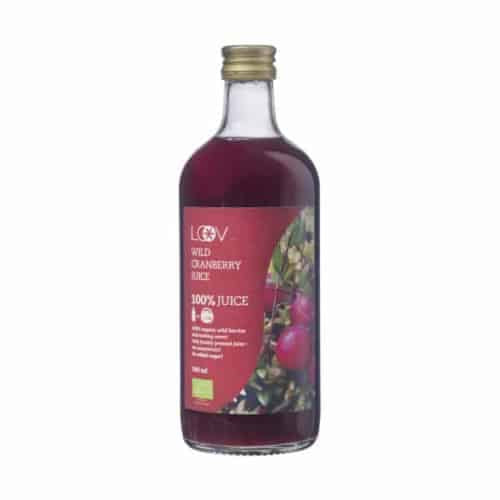 Organic Wild Cranberry Organic Wild CranberryJuice Buy Now |
Visit our website or Amazon store today to discover our selection of organic wild superfoods plucked from magical Nordic forests.
Share on Pinterest:

